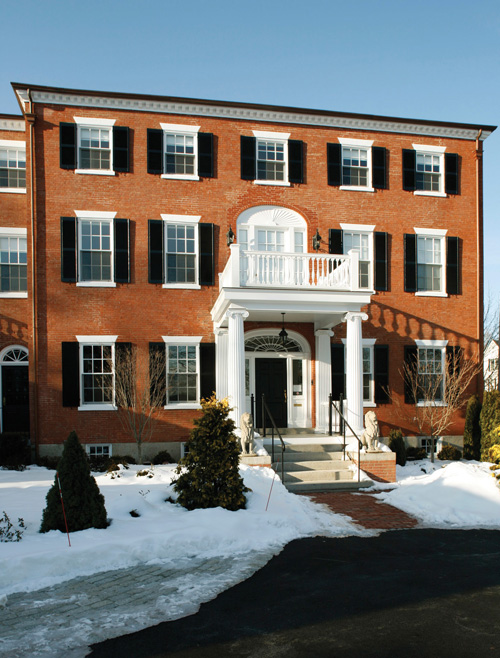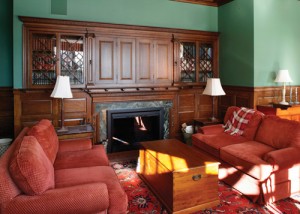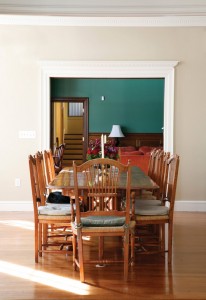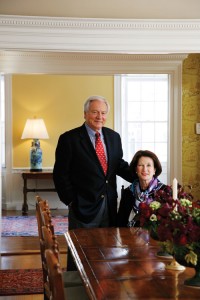 The Joseph Story House, Salem, MA.” />
The Joseph Story House, Salem, MA.” />
The Joseph Story House, Salem, MA.
 Martha, a trustee for the Peabody Essex Museum, and former finance chairman for Mitt Romney and Bill Weld, is wading through the extensive paperwork involved in the LEED certification. Her involvement with the PEM also gave her credibility when she spent months in meetings with the Salem Historic Commission to gain approval for the Chayets’ ambitious plans. In addition to replacing all of the windows and installing an elevator, the scope of the work included tearing down a garage that was unoriginal to the property; adding a new brick carriage house wing containing a kitchen, garage, loft media room, and pergola; and renovating two apartments and a courtyard that open onto the Oliver Street side of the house.
The storied pedigree of the house was a big motivator for both Chayets. Its previous owners include Joseph Story, an associate justice of the Supreme Court; Dr. Amos Johnson, grandfather to the Fidelity Investment Johnsons; and the Vaughan family, whose members made significant contributions to early Antarctic exploration and aviation. The Chayets liken their roles as stewards of the property and strive to honor its legacy in their own entertaining.
Architect Richard Long rose to tricky aesthetic challenges like extending the length of balusters on the prominent front upper balcony six inches in order to meet code without sacrificing any architectural integrity. The Chayets’ contractors, DeIulis Brothers of Lynn, were also chosen for their meticulous care and ability to preserve the home’s history amidst repairs and restoration.
Martha, a trustee for the Peabody Essex Museum, and former finance chairman for Mitt Romney and Bill Weld, is wading through the extensive paperwork involved in the LEED certification. Her involvement with the PEM also gave her credibility when she spent months in meetings with the Salem Historic Commission to gain approval for the Chayets’ ambitious plans. In addition to replacing all of the windows and installing an elevator, the scope of the work included tearing down a garage that was unoriginal to the property; adding a new brick carriage house wing containing a kitchen, garage, loft media room, and pergola; and renovating two apartments and a courtyard that open onto the Oliver Street side of the house.
The storied pedigree of the house was a big motivator for both Chayets. Its previous owners include Joseph Story, an associate justice of the Supreme Court; Dr. Amos Johnson, grandfather to the Fidelity Investment Johnsons; and the Vaughan family, whose members made significant contributions to early Antarctic exploration and aviation. The Chayets liken their roles as stewards of the property and strive to honor its legacy in their own entertaining.
Architect Richard Long rose to tricky aesthetic challenges like extending the length of balusters on the prominent front upper balcony six inches in order to meet code without sacrificing any architectural integrity. The Chayets’ contractors, DeIulis Brothers of Lynn, were also chosen for their meticulous care and ability to preserve the home’s history amidst repairs and restoration.
 Painter Steve Berenson of Marblehead exercised a similar fastidious attention to detail. “We spent 11 months on 28 rooms. It was a dream job but not without its challenges,” Berenson says. Berenson and his crew matched 200- year old stain in the oak-paneled family room, scrubbed and restored every single cement rain gutter bracket on the outside of the house, and refinished the triple-tier water fountain in the center of the front yard to resemble its original appearance.
By any measure, the Chayets now have a magnificent dwelling to call home. Alongside stunning aesthetics and a storied pedigree, they are proud to instill the house with a green legacy. “Environmental stewardship is the central issue of our time,” says Martha, who was raised on a wheat farm in Oklahoma. “Making our house green is a simple step, but it’s a goal you can actually accomplish that makes you feel like you’re doing your part,” she says.
It’s also a step of which the house’s ancestors would no doubt approve. As Long explains, “One of the nice things about eighteenth and nineteenth century buildings is that our ancestors were very much aware of being green. The Story House was already on its way two hundred years ago. For example, you have vast amounts of windows on the south-facing side of the house, and chimneys on the north. They knew to capitalize on the sun, and to put their backs to the wind, so to speak. Being green is good old-fashioned Yankee common sense.”
Good Ole Yankee Ingenuity:
Opposite, bottom row, middle, Dutch delft tiles with painted harbor scenes from the late 1700s frame the fireplace in Neil Chayet’s study; bottom row, right, a bust of Abraham Lincoln donned with Middlesex Club awards given to Chayet, a former president of the club. This page, top row, left, quarter sawn oak trim and cabinets in the 1901 Von family room; bottom row, left, the kitchen looking into the pantry; middle, the front facade of the home; right, looking through the dining room into the Von room. Previous spread, from left, the Von room; the pantry with Vermont marble countertops and a stainless steel hatch that leads to the recycling bin in the garage; a McIntire-carved chair in the living room.
The Preservation Society:
This page, left, the main staircase leads to the second floor; right, in the study, Hindu deities Ganesha and Buddha share the mantle with a drawing of Joseph Story, the former associate justice of the Supreme Court for whom this house, built in 1811, was named. The Story House is listed with the National Register of Historic Landmarks. Opposite, Neil and Martha Chayet in their dining room. The Chayets moved from Manchester to Salem in 2005 and spent two years upgrading this 9,000 square-foot house so that it can be certified as one of 1,200 homes across the country to receive a LEED silver certification, which is the green version of the Good Housekeeping Seal of Approval. “It became important for us to validate that our historic preservation is green,” Neil says. Upgrades include a $100,000 geothermal heating and cooling system as well as replacing all the windows, building a carriage house wing, and installing an elevator.
Painter Steve Berenson of Marblehead exercised a similar fastidious attention to detail. “We spent 11 months on 28 rooms. It was a dream job but not without its challenges,” Berenson says. Berenson and his crew matched 200- year old stain in the oak-paneled family room, scrubbed and restored every single cement rain gutter bracket on the outside of the house, and refinished the triple-tier water fountain in the center of the front yard to resemble its original appearance.
By any measure, the Chayets now have a magnificent dwelling to call home. Alongside stunning aesthetics and a storied pedigree, they are proud to instill the house with a green legacy. “Environmental stewardship is the central issue of our time,” says Martha, who was raised on a wheat farm in Oklahoma. “Making our house green is a simple step, but it’s a goal you can actually accomplish that makes you feel like you’re doing your part,” she says.
It’s also a step of which the house’s ancestors would no doubt approve. As Long explains, “One of the nice things about eighteenth and nineteenth century buildings is that our ancestors were very much aware of being green. The Story House was already on its way two hundred years ago. For example, you have vast amounts of windows on the south-facing side of the house, and chimneys on the north. They knew to capitalize on the sun, and to put their backs to the wind, so to speak. Being green is good old-fashioned Yankee common sense.”
Good Ole Yankee Ingenuity:
Opposite, bottom row, middle, Dutch delft tiles with painted harbor scenes from the late 1700s frame the fireplace in Neil Chayet’s study; bottom row, right, a bust of Abraham Lincoln donned with Middlesex Club awards given to Chayet, a former president of the club. This page, top row, left, quarter sawn oak trim and cabinets in the 1901 Von family room; bottom row, left, the kitchen looking into the pantry; middle, the front facade of the home; right, looking through the dining room into the Von room. Previous spread, from left, the Von room; the pantry with Vermont marble countertops and a stainless steel hatch that leads to the recycling bin in the garage; a McIntire-carved chair in the living room.
The Preservation Society:
This page, left, the main staircase leads to the second floor; right, in the study, Hindu deities Ganesha and Buddha share the mantle with a drawing of Joseph Story, the former associate justice of the Supreme Court for whom this house, built in 1811, was named. The Story House is listed with the National Register of Historic Landmarks. Opposite, Neil and Martha Chayet in their dining room. The Chayets moved from Manchester to Salem in 2005 and spent two years upgrading this 9,000 square-foot house so that it can be certified as one of 1,200 homes across the country to receive a LEED silver certification, which is the green version of the Good Housekeeping Seal of Approval. “It became important for us to validate that our historic preservation is green,” Neil says. Upgrades include a $100,000 geothermal heating and cooling system as well as replacing all the windows, building a carriage house wing, and installing an elevator.

